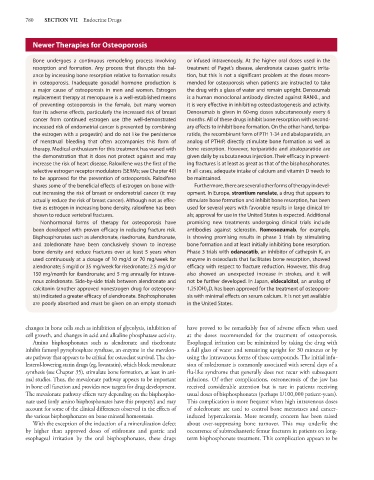Page 794 - Basic _ Clinical Pharmacology ( PDFDrive )
P. 794
780 SECTION VII Endocrine Drugs
Newer Therapies for Osteoporosis
Bone undergoes a continuous remodeling process involving or infused intravenously. At the higher oral doses used in the
resorption and formation. Any process that disrupts this bal- treatment of Paget’s disease, alendronate causes gastric irrita-
ance by increasing bone resorption relative to formation results tion, but this is not a significant problem at the doses recom-
in osteoporosis. Inadequate gonadal hormone production is mended for osteoporosis when patients are instructed to take
a major cause of osteoporosis in men and women. Estrogen the drug with a glass of water and remain upright. Denosumab
replacement therapy at menopause is a well-established means is a human monoclonal antibody directed against RANKL, and
of preventing osteoporosis in the female, but many women it is very effective in inhibiting osteoclastogenesis and activity.
fear its adverse effects, particularly the increased risk of breast Denosumab is given in 60-mg doses subcutaneously every 6
cancer from continued estrogen use (the well-demonstrated months. All of these drugs inhibit bone resorption with second-
increased risk of endometrial cancer is prevented by combining ary effects to inhibit bone formation. On the other hand, teripa-
the estrogen with a progestin) and do not like the persistence ratide, the recombinant form of PTH 1-34 and abaloparatide, an
of menstrual bleeding that often accompanies this form of analog of PTHrP, directly stimulate bone formation as well as
therapy. Medical enthusiasm for this treatment has waned with bone resorption. However, teriparatide and abaloparatide are
the demonstration that it does not protect against and may given daily by subcutaneous injection. Their efficacy in prevent-
increase the risk of heart disease. Raloxifene was the first of the ing fractures is at least as great as that of the bisphosphonates.
selective estrogen receptor modulators (SERMs; see Chapter 40) In all cases, adequate intake of calcium and vitamin D needs to
to be approved for the prevention of osteoporosis. Raloxifene be maintained.
shares some of the beneficial effects of estrogen on bone with- Furthermore, there are several other forms of therapy in devel-
out increasing the risk of breast or endometrial cancer (it may opment. In Europe, strontium ranelate, a drug that appears to
actually reduce the risk of breast cancer). Although not as effec- stimulate bone formation and inhibit bone resorption, has been
tive as estrogen in increasing bone density, raloxifene has been used for several years with favorable results in large clinical tri-
shown to reduce vertebral fractures. als; approval for use in the United States is expected. Additional
Nonhormonal forms of therapy for osteoporosis have promising new treatments undergoing clinical trials include
been developed with proven efficacy in reducing fracture risk. antibodies against sclerostin. Romosozumab, for example,
Bisphosphonates such as alendronate, risedronate, ibandronate, is showing promising results in phase 3 trials by stimulating
and zoledronate have been conclusively shown to increase bone formation and at least initially inhibiting bone resorption.
bone density and reduce fractures over at least 5 years when Phase 3 trials with odanacatib, an inhibitor of cathepsin K, an
used continuously at a dosage of 10 mg/d or 70 mg/week for enzyme in osteoclasts that facilitates bone resorption, showed
alendronate; 5 mg/d or 35 mg/week for risedronate; 2.5 mg/d or efficacy with respect to fracture reduction. However, this drug
150 mg/month for ibandronate; and 5 mg annually for intrave- also showed an unexpected increase in strokes, and it will
nous zoledronate. Side-by-side trials between alendronate and not be further developed. In Japan, eldecalcitol, an analog of
calcitonin (another approved nonestrogen drug for osteoporo- 1,25(OH) 2 D, has been approved for the treatment of osteoporo-
sis) indicated a greater efficacy of alendronate. Bisphosphonates sis with minimal effects on serum calcium. It is not yet available
are poorly absorbed and must be given on an empty stomach in the United States.
changes in bone cells such as inhibition of glycolysis, inhibition of have proved to be remarkably free of adverse effects when used
cell growth, and changes in acid and alkaline phosphatase activity. at the doses recommended for the treatment of osteoporosis.
Amino bisphosphonates such as alendronate and risedronate Esophageal irritation can be minimized by taking the drug with
inhibit farnesyl pyrophosphate synthase, an enzyme in the mevalon- a full glass of water and remaining upright for 30 minutes or by
ate pathway that appears to be critical for osteoclast survival. The cho- using the intravenous forms of these compounds. The initial infu-
lesterol-lowering statin drugs (eg, lovastatin), which block mevalonate sion of zoledronate is commonly associated with several days of a
synthesis (see Chapter 35), stimulate bone formation, at least in ani- flu-like syndrome that generally does not recur with subsequent
mal studies. Thus, the mevalonate pathway appears to be important infusions. Of other complications, osteonecrosis of the jaw has
in bone cell function and provides new targets for drug development. received considerable attention but is rare in patients receiving
The mevalonate pathway effects vary depending on the bisphospho- usual doses of bisphosphonates (perhaps 1/100,000 patient-years).
nate used (only amino bisphosphonates have this property) and may This complication is more frequent when high intravenous doses
account for some of the clinical differences observed in the effects of of zoledronate are used to control bone metastases and cancer-
the various bisphosphonates on bone mineral homeostasis. induced hypercalcemia. More recently, concern has been raised
With the exception of the induction of a mineralization defect about over-suppressing bone turnover. This may underlie the
by higher than approved doses of etidronate and gastric and occurrence of subtrochanteric femur fractures in patients on long-
esophageal irritation by the oral bisphosphonates, these drugs term bisphosphonate treatment. This complication appears to be

